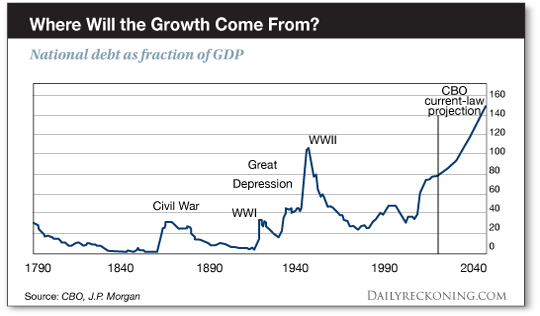Is Trump’s Tax Cut “Paying for Itself”?
There is absolutely nothing wrong with America’s finances that a miracle couldn’t fix… as the great man said.
We learn this week that 2018’s budget deficit currently rises Himalayan-high to $895 billion — a 39% increase over last year.
The Congressional Budget Office (CBO) announced in April that the budget deficit would exceed $1 trillion in 2020.
But CBO now estimates the deficit will top $1 trillion in 2019… one year ahead of schedule.
The reason, simple as snow and as obvious as the nose on a man’s face:
The United States government lays out far more money than it hauls aboard.
The Republic demands its bread… circuses… its gladiator combats.
But it prefers to buy on credit.
“Defense” spending — up 10% on the year…
Social Security outlays — up 5%…
Medicare — up 7%.
Overall federal spending has increased 7% this fiscal year… while tax revenues have increased only 1%.
To the business we must add a 25% increase in net interest on the public debt.
The economic men in practice at Washington assured us the Trump tax cuts would “pay for themselves” through higher growth.
Treasury Secretary Steve Mnuchin — for example — assured us, “The plan will pay for itself with growth.”
Then we come to President Trump’s senior economic adviser…
Larry Kudlow is a swell enough fellow who is nonetheless trapped in 1981… like a fly trapped in amber.
He argues that “Even the CBO numbers show now that the entire $1.5 trillion tax cut is virtually paid for by higher revenues and better nominal GDP.”
But if outlays are up 7% while revenues are up 1%… how is the entire $1.5 trillion tax cut being paid for by higher revenues and better nominal GDP?
We will gladly take correction if mistaken.
But in our court stands economist Greg Mankiw.
Mankiw was George W. Bush’s chairman of the president’s Council of Economic Advisers.
From whom:
I do not know what numbers Larry is referring to… A reasonable rule of thumb, in my judgment, is that about one-third of the cost of tax cuts is recouped via faster economic growth.
We’re heart and soul for tax cuts — provided they are twinned with spending cuts to match.
There is something within the liver and lights that demands a square accounting.
Spend less, it whispers — or more if you must.
But pay your way as you go.
Borrowing from tomorrow to pay for today is the way of the scoundrel… the profligate… the serial bankrupt.
“The wicked borrows, and cannot pay back”… as Psalm 37:21 reads.
But worry not, soothes the official voice — deficits don’t matter.
And for years they haven’t… or not overmuch.
But the laws of economics will not be forever conned, the old-timers insist.
Actions demand reactions… scales must ultimately balance… the free lunch has no existence this side of paradise.
We suspect a great reckoning will prove once and for all that deficits do matter.
At writing the national debt rings in at $21,479,156,738,092… and rising… rapidly.
For your viewing pleasure, CBO’s projected trajectory of the national debt as a percentage of GDP:

The greatest burglars of America’s fiscal future?
Social Security, Medicare and Medicaid… with interest on the debt into the bargain.
If you accept the CBO at its word, mandatory spending — including these budget-busters and a few others — will constitute 78% of federal spending by 2026.
That leaves only 22 cents per dollar for education, science, transportation and a hundred other priorities… including defense.
Former Treasury official Peter Fisher’s waggish observation gains currency with each passing year:
The federal government, says he, is a “gigantic insurance company (with a sideline business in national defense and homeland security).”
Much truth is spoken in jest.
With a spirit of doom upon us today, let us sink further into the mire…
According to no less an authority than the United States Treasury, projected tax revenues to fund Social Security and Medicare over the next 75 years fall $46.7 trillion short.
“Unfunded liabilities,” these are called.
But even these $46.7 trillion of unfunded liabilities may tell a mere fraction of America’s true indebtedness…
Economist and Boston University professor Larry Kotlikoff says Social Security, Medicare and Medicaid are not fully accounted for in official number crunching.
These accounting shell games mask the actual debt, says Kotlikoff.
What is America’s actual debt?
Over the next 75 years, this Cassandra projects America’s true debt at an intergalactic $210 trillion.
Kotlikoff, shaking his head in despair:
We have all these unofficial debts that are massive compared to the official debt. We’re focused just on the official debt, so we’re trying to balance the wrong books…
If you add up all the promises that have been made for spending obligations, including defense expenditures, and you subtract all the taxes that we expect to collect, the difference is $210 trillion. That’s the fiscal gap. That’s our true indebtedness.
Kind heaven, no — could our fair land be $210 trillion in debt?
On days such as this, when our hopes for America crash upon the shoals of actuarial mathematics and we wonder why we even bother… our thoughts turn to author Robert Benchley.
We have told the tale before, but today we tell it again…
Benchley sat at his typewriter one day to tackle a vexing subject.
He got one word into it — “The” — when he came upon a brick wall. The words would not come.
He soon threw up the sponge… and abandoned his typewriter in frustration.
After soaking his head in the hotel bar he returned to visit the task anew, freshly inspired.
With only one word to work with — “The” — Benchley rapidly hammered out his article, presented here in its entirety:
“The hell with it.”
Regards,
Brian Maher
Managing editor, The Daily Reckoning



Comments: